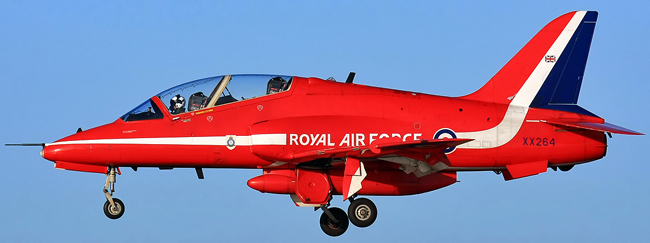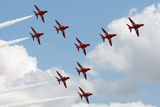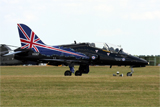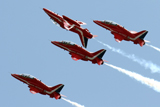BAe Hawk

BAe Hawk T.1 - XX264
In 1964 the Royal Air Force specified a requirement for a new initial jet trainer to replace the Folland Gnat. The SEPECAT Jaguar was originally intended for this role, but it was soon realised that it would be too complex an aircraft for initial jet training. Accordingly, in 1968 Hawker Siddeley began the design of a much simpler strictly subsonic trainer, the HS.1182. It was to have tandem seating and would be capable of carrying armaments, which would enable it to be used as a weapons trainer and in light combat roles. Renamed Hawk in 1973, the aircraft first flew on 21st August 1974. It entered RAF service in April 1976, replacing the Gnat and Hawker Hunter in the advanced training and weapons training roles respectively. The following year Hawker Siddeley merged with other British aircraft companies to form the nationalised British Aerospace (BAe), which subsequently became BAE Systems upon merger with Marconi Electronic Systems in 1999.
The Hawk comes in many variants, a few of which are outlined below.
The Hawk 50 was the original export trainer version, from which the T-45 Goshawk was derived. The Mk.50 offered a limited attack capability. Finland, Indonesia and Kenya all ordered this variant.
Another export version, replacing the Hawk 50, intended for conversion and weapons training. Weapons carriage is increased. It is a two-seater, has uprated Rolls-Royce Adour 861 engines and is capable of a level speed at altitude of 555 knots (1028 km/h) or Mach 0.84.
A two-seat advanced weapons trainer with additional avionics, including forward looking infrared, a redesigned wing and HOTAS.
The Hawk 100 series retains the highly-acclaimed design qualities of the original Hawk trainer. The raised rear cockpit combines excellent forward visibility for the instructor, with the capability to demonstrate all of the aircraft's functions to the student pilot in the front seat. It excels as an advanced flight trainer and operational aircraft. The Hawk 100 has also been developed into an advanced weapon systems trainer with enhanced ground attack capability. It introduces pilots to modern combat avionic systems with multi-purpose displays linked to an avionic/weapons systems digital databus. A high performance navigation system and head-up display/weapon aiming computer are combined with a forward looking infra-red (FLIR) sensor and laser rangefinder to give a highly accurate poor weather and night operational capability. Pilot workload is reduced by hands-on-throttle-and-stick (HOTAS) controls for the selection of weapons, sensors and defensive aids
The Hawk Lead In Fighter Trainer (LIFT) is the version selected by the South African Air Force in December 1999. This variant is powered by the Adour 951. The LIFT benefits from development carried out for the Australian Mk.127. The next generation Hawks (120, 127 and 128) feature a new wing, forward and center fuselage, fin and tailplane. The aircraft have only 10% commonality with the existing first generation aircraft. The new variants also have four times the fatigue life of the original aircraft.
The latest export variant of the Hawk (also known as the A.J.T.). The Mk.132 is destined to enter service with the Indian Air Force (IAF) after one of the most protracted procurement processes in history, with two decades having elapsed between the initial interest and the contract signing on March 26th, 2004. The IAF will receive 24 aircraft directly from BAE Systems starting in 2007 and another 42 will be assembled by Hindustan Aeronautics Ltd. during 2008-10. The Indian Navy is also likely to order a small number. Further orders will be a function of how quickly India is able to develop the Combat Air Trainer, a twin-engine trainer derived from the HJT-36 Sitara, whose model was displayed at the Aero India 2005 air show in February 2005.
The Hawk 200 series aircraft is optimised as a single seat lightweight multi role fighter with full ground attack and air-to-air defense capability. It features a combination of state-of-the-art digital computerised avionics with a small, uncomplicated and well proven airframe. Hawk 200 features extensive commonality with current production two-seat Hawk variants. The revised forward fuselage houses the fully integrated avionics system including the Westinghouse APG-66H multi-mode pulse-doppler radar, which offers outstanding air defence and air-to-surface capability. It has Rolls-Royce Adour 871 engines. This variant provides a low cost but effective multi-role aircraft. Indonesia, Malaysia and Oman have ordered 62 aircraft. BAE Systems flies a Mk.200 in the demonstrator role.



The T.1 (Trainer Mark 1) was the original version of the Hawk used by the RAF, deliveries commencing in November 1976. The UK ordered 176 T.1s. From 1983 to 1986, some Hawks were equipped as the short-range interceptor aircraft for point defence. 88 T.1s were modified to carry two AIM-9L Sidewinder air-to-air missiles in addition to the centerline gun pod carrying a single 30 mm ADEN cannon. These aircraft were designated T.1A. In the event of war, they would have worked in collaboration with Tornado F.3 aircraft, which would use their Foxhunter search radars to vector the radar-less Hawks against enemy targets. Such missions would have been flown by instructor pilots. Conversions were completed in 1986. With the fall of the Soviet Union and the end of the Cold War, RAF Hawks are no longer tasked with this role.
The most famous operator of the Hawk is the RAF's Red Arrows aerobatic team, which adopted the plane in 1979. The Finnish Air Force aerobatics team, the Midnight Hawks, also uses the aircraft. The Hawk has excellent maneuverability, and while it is not capable of supersonic speed in level flight, it can attain Mach 1.2 in a dive, allowing trainees to experience trans-sonic handling without the cost of a supersonic trainer.
The Hawk subsequently replaced the English Electric Canberra in the target towing role. In 2009, the RAF began receiving the first Hawk T.2 aircraft, which will replace the T.1 in the advanced trainer role.
The Royal Navy acquired a dozen Hawk T.Mk 1/1As from the RAF, for use as aerial targets for the training of ships gunners and radar operators. Eighty Hawk TMk 1/1A aircraft have been upgraded under the Fuselage Replacement Program (FRP), which involves the replacement of the aft center and rear fuselage sections, using new build sections derived from the Mk. 60.
| Model | Production |
|---|---|
| T.1 | 176 |
| T.1A | 88 (All T.1 upgrades) |
| 50 | 50 (Finland AF) |
| 51 | 7 (Finland AF) |
| 52 | 12 (Kenyan AF) |
| 53 | 20 (Indonesian AF) |
| 60 | 8 (Zimbabwe AF) |
| 60A | 5 (Zimbabwe AF) |
| 61 | 8 (Dubai) |
| 62 | Proposed Hawks for Venezuela AF |
| 63 | 16 (Abu Dhabi |
| 63A | 14 (Abu Dhabi) |
| 63C | 5 (Abu Dhabi) |
| 64 | 12 (Kuwait AF) |
| 65 | 30 (Saudi Arabia AF) |
| 65A | 20 (Saudi Arabia AF) |
| 66 | 20 (Swiss AF) |
| 67 | 20 (South Korean AF) |
| 102 | 18 (Abu Dhabi) |
| 103 | 4 (Oman AF) |
| 108 | 10 (Malaysian AF) |
| 109 | 8 (Indonesian AF) |
| 115 | 21 (Canadian International Training Program) |
| 120 / LIFT | 24 (South African AF) |
| 127 | 39 ( 33 for Australian AF, 6 for Bahrain AF) |
| 128 | 44 (RAF) |
| A.J.T. | 66 (Indian AF) |
| 203 | 12 (Oman AF) |
| 208 | 18 (Malaysian AF) |
| 209 | 32 (Indonesian AF) |
| Length: | 38.11 ft (11.86 m) |
| Width: | 30.97 ft (9.39 m) |
| Height: | 13.12 ft (3.99 m) |
| Accommodation: | 2 |
| Hardpoints: | 5 |
| Empty Weight: | 8,040 lbs (3647 kg) |
| MTOW: | 12,566 lbs (5700 kg) |
| Max Speed: | 645 mph (1038 km/h; 560 kts) |
| Max Range: | 1,565 miles (2,520 km) |
| Rate-of-Climb: | 9,300 ft/min |
| Service Ceiling: | 44,500 ft (13,565 m) |
| Engine: | 1× Rolls-Royce Adour Mk.951 turbofan with FADEC, 29 kN (6,500 lbf) |
| Armament Standard: | None, all armaments are optional |
| Armament Optional: | 1× 30 mm ADEN cannon 4× AIM-9 Sidewinder or ASRAAM missiles Up to 6,800 lb (3,085 kg) of weapons |
